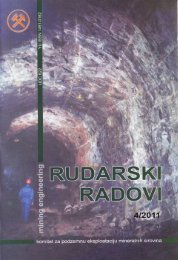Institut za rudarstvo i metalurgiju Bor
Institut za rudarstvo i metalurgiju Bor
Institut za rudarstvo i metalurgiju Bor
You also want an ePaper? Increase the reach of your titles
YUMPU automatically turns print PDFs into web optimized ePapers that Google loves.
Practically, the “in-situ” exploitation<br />
suffers the challenges to protect the<br />
ground water on contamination by the<br />
kerogene oil and other produced gases and<br />
sediments. Promising so called “freezewall”<br />
technology has been tested to isolate<br />
the groundwater from subsurface area<br />
where the “in-situ” process is carried out<br />
until the postproduction and remediation<br />
activities of land is complete. [7]<br />
AIR POLLUTANTS IN THE<br />
OIL SHALE COMBUSTION<br />
The main air pollutants in the oil shale<br />
combustion are nitrogen oxides, sulfur<br />
dioxide, hydrogen chloride and solid particles.<br />
The most harmful gas that is emitted<br />
CO2. Air pollutant concentration in the<br />
exhaust gases primarily depends on combustion<br />
technology and combustion regime,<br />
while the emission of solid particles<br />
is determined by the efficiency of device<br />
for catching the fly ash. Regarding to the<br />
emission of air pollutant, oil shale is characterized<br />
by low content of nitrogen in<br />
organic matter (0.3%), high concentration<br />
of organic sulfur (1.6 to 1.8% in a part that<br />
is accepted as a fuel), high Ca /S ratio (8-<br />
10) and an abundance of carbonate minerals<br />
(16-19% mineral CO2 – in a part that is<br />
accepted as a fuel).<br />
NOx during fuel combustion can be<br />
formed in the following ways: in the reaction<br />
between the nitrogen and oxygen<br />
from the air (thermal NOx), in the reaction<br />
between hydrocarbon radicals and molecular<br />
nitrogen (immediate or rapid NOx)<br />
and nitrogen from fuels. The most important<br />
parameter that affects the amount of<br />
nitrogen oxides in the exhaust gases is<br />
oxygen concentration (high air factor).<br />
The main sulfur component in the oil<br />
shale is calcium. Therefore, in order to<br />
characterize the potential in the process of<br />
sulfur capturing, the ratio Ca/S is used.<br />
Because oil shale contains the alkaline<br />
metals, a part of sulfur is linked with this<br />
component, usually in a form of sulfate.<br />
However, not all alkali metals present in<br />
the fuel converted to sulfate, primarily one<br />
part depends on the volatility of alkali<br />
metals from mineral matter in the combustion<br />
process. Emission of sulfur dioxide<br />
and volume of conversion into vapor from<br />
this part of combusted sulfur, during combustion<br />
of oil shale, depends on many<br />
factors.<br />
Carbon dioxide is classified as a greenhouse<br />
gas. It is formed in the reactions of<br />
combustion the organic carbon and minerals<br />
present in the fuel as carbonates. Full<br />
conversion of organic carbon in CO2 is<br />
possible only in complete combustion. Release<br />
of carbon dioxide from the carbonate<br />
mineral, is determined by the behavior of<br />
fuel mineral in the combustion process.<br />
Combustion technology that is used for fuel<br />
burning does not affect significantly the<br />
effects and quantity of CO2 formation from<br />
organic. Certainly, the combustion technology<br />
has a great impact on emission of CO2<br />
mineral. Concentration of CO2 mineral,<br />
formed by the carbonate compound, is determined<br />
by the conditions of thermal decomposition<br />
of minerals and also by direct<br />
combustion of gaseous components present<br />
in the exhaust gases and minerals that contain<br />
CO2. [4]<br />
EFFECT OF UNDERGROUND<br />
GASIFICATION<br />
Care about the environment is one of<br />
the most important factors that have to be<br />
taken into account when it is accessed to<br />
the process of underground gasification<br />
(UG) and if its impact on the environment<br />
is barely noticeable and very low. The<br />
main product of gasification is gas, although<br />
some by-products remain under<br />
the earth, or used by the conventional<br />
processes or injected back into the layer.<br />
At the same time there are still some significant<br />
impacts that must be taken into<br />
account, in particular, the underground<br />
and above-ground impact. Basically, hydrological,<br />
geological and hydrogeologi-<br />
No 1,2010. 143<br />
MINING ENGINEERING



